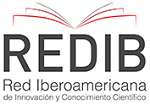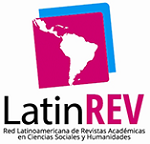Remoción de metales pesados desde efluentes mineros, mediante cáscaras de frutas.
DOI:
https://doi.org/10.15649/2346030X.627Palabras clave:
biosorción, fibras lignocelulósicas, metales pesados, efluentes minerosResumen
El hombre en sus distintos procesos productivos ha generado modificaciones al ambiente. La minería metalúrgica no se exime de esto, ya que muchos de los residuos producidos, en especial los efluentes, no cuentan con ningún tipo de tratamiento antes de ser vertidos. El objetivo de la investigación fue evaluar la eficiencia de remoción del Cu, Fe y Pb del efluente minero-metalúrgicos a escala de laboratorio mediante la aplicación de un filtro bioadsorbente con fibras lignocelulósicas (cáscaras de plátano, coco y naranja). Se diseñó 10 filtros compuestos por cáscaras de plátano, coco y naranja, en diferentes proporciones (siendo 100 gr el 100 %), según lo establecido mediante el Diseño de mezclas Simplex Lattice, con tres metales a remover (Cu, Fe y Pb). Se trabajó a un pH de 7.3, tiempo de contacto de 3 horas y tamaño de partícula de 0.250 mm, en todos los tratamientos. Los resultados muestran que para el Cu el mejor tratamiento fue (T2), con 100 gr de cáscaras de coco (96.36%); para el hierro el tratamiento seis (T6) compuesto por coco-naranja (50 gr de cada uno) con una eficiencia de (92.05%); y el plomo presentó una mayor remoción del 97.34% con los tratamientos tres (T3) y seis (T6) compuesto por 100 gr de naranja y coco-naranja (50 gr de cada uno), respectivamente. Los datos se ajustaron mejor al modelo de regresión cúbica especial, siendo para el cobre el valor P de 0.000305 y el coeficiente de determinación R2 0.790156. Para el hierro, el valor P 0.000000 y coeficiente de determinación R2 0.930029. El valor P del plomo fue de 0.000034 y el coeficiente de determinación R2 0.719867. Considerando que el valor de R2, es mejor mientras más se acerca a 1, y que (p<0,05) es significativo.
Referencias
Y.C. Reyes, O. Torres, M. Díaz y E. Gonzalez, "Heavy metals contamination: implications for health and food safety", Revista Ingeniería, Investigación y Desarrollo, Vol. 16 Nº 2, Julio-Diciembre pp. 66-77, 2006.
C. Tejada, A. Herrera y J. Nuñez, "Removal of lead using residual biomass of orange peel and corncob", Rev. U.D.C.A Act. & Div. Cient. 19(1): 169-178, Enero-Junio, 2016.
A. Garcia-Barrrera, "Elaboración de una biorresina intercambiadora de cationes a partir de cáscara de plátano o guineo para eliminar metales pesados en agua contaminada", 1ª ed. – Santa Tecla, El Salv. : ITCA Editores, pp. 47. 2016.
T. Dávila, N. Sánchez y D. Ordoñez,. "Evaluation of agroindustrial waste as bio-filters: removal of cr (vi) in tannery synthetic effluents. Biotecnología en el Sector Agropecuario y Agroindustrial", Edición Especial No. 1 (49-58) Enero _ Junio 2017.
D. Abdollah, G. Hafez, D. Parviz, K. Amir, H. Syed. A. Hasan y A.B. Poormohammadi, "An Investigation and Comparison of Removing Heavy Metals (Lead and Chromium) from Aqueous Solutions Using Magnesium Oxide Nanoparticles", Pol. J. Environ. Stud. 25(2):557–562. 2016.
Y.Z. Dongxiao-Ouyang, I. Liang-Hu, Z, Qiang, Y. Hu-and- Zhiguo-He, "Research on the Adsorption Behavior of Heavy Metal Ions by Porous Material Prepared with Silicate Tailings". Minerals, 9, 291; doi: 10.3390/min9050291. 2019.
B. Dhir y R. Kumar, "Adsorption of Heavy Metals by Salvinia Biomass and Agricultural Residues", Int. J. Environ. Res., 4(3):427-432, Summer 2010.
T. Said, 1 Smaail-Radi, E. Abderrahman,1. Khadija-Haboubi, S.D. Maryse-Bacquet, Z. Mustapha y Y. Garcia. "Removal of toxic heavy metals from river water samples using a porous silica surface modified with a new β-ketoenolic host", Beilstein J Nanotechnol. 2019; 10: 262–273.
V. Javanbakht, S. Amir-Alavi y H. Zilouei. "Mechanisms of heavy metal removal using microorganisms as biosorbent", Water Science & Technology 69(9):1775-1787 · May 2014.
J. Wang y C. Chen, "Biosorbents for Heavy Metal Removal and Their Future", Biotechnology advances 27(2):195-226 · March 2009.
H. Hussein, S. Farag-Ibrahim, K. Kandeel y H. Moawad, "Biosorption of heavy metals from waste water using Pseudomonas sp." Electronic Journal of Biotechnology Vol.7 No.1, Issue of April 15, 2004.
H. Zhang. "Biosorption of heavy metals fronm aqueous solution using keratin biomaterials". Doctoral Thesis, Universidad de Barcelona España. 2014.
S.T. El-Wakeel1, R.M. Moghazy, A. Labena y Sh. Husien, "Algal biosorbent as a basic tool for heavy metals removal; the first step for further applications·, J. Mater. Environ. Sci., Volume 10, Issue1, Page 75-87. 2019.
R. García, J. Campos, J.A. Cruz, Ma.E. Calderón, Ma.E. Raynal y G. Buitrón, "Biosorption of cd, cr, mn, and pb from aqueous solutions by bacillus sp strains isolated from industrial waste activate sludge", revista especializada en ciencias químico-biológicas, 19(1):5-14, 2016.
M. Czikkely, E. Neubauer, I. Fekete, P. Ymeri y C. Fogarassy. "Review of Heavy Metal Adsorption Processes by Several Organic Matters from Wastewaters", Water, 10, 1377; doi: 10.3390/w10101377. 2018.
N. El-Ahmady-El-Naggar, A, Ragaa-Hamouda, E. Ibrahim - Mousa, S. Marwa, Abdel-Hamid y H, Nashwa-Rabei, "Biosorption optimization, characterization, immobilization and application of Gelidium amansii biomass for complete Pb2+ removal from aqueous solutions", Sci Rep; 8: 13456. 2018.
M. Shafiq, A.A. Alazba y M.T. Amin. "Removal of Heavy Metals from Wastewater using Date Palm as a Biosorbent: A Comparative Review", Sains Malaysiana 47(1) 35–49. 2018.
L.M. Vera, D, Bermejo, M. F. Uguña, N. Garcia, M. Flores, E. González, "Fixed bed column modeling of lead (II) and cadmium (II) ions biosorption on sugarcane bagasse". https://doi.org/10.4491/eer.2018.042. Environ. Eng. Res. 2019.
N. Chandra-Joshi. "A Brief Discussion on Biosorption and Biosorption Technology. Journal of Pharmaceutical", Chemical and Biological Sciences. December 2017- February; 5(4):330-336. 2018.
T. Rezic, M. Zeiner, B. Santek y S. Novak, "Heavy Metals Removal in a Horizontal Rotating Tubular Bioreactor". Water Air and Soil Pollution 214(1):343-355 · April 2011.
J. Wang, Y. Zhao, L. Yang y T. Nannan, "Removal of Heavy Metals from Urban Stormwater Runoff Using Bioretention", Media Mix. Water 9(11):854 · November 2017.
C. Tejada, A. Herrera y E. Ruiz, "Kinetic and isotherms of biosorption of Hg (II) using citric acid treated residual materials". Ingeniería y Competitividad, Volumen 18, No. 1, p. 117 - 127 2016.
S. Singh y D. Bahadur. "Functional Oxide Nanomaterials and Nanocomposites for the Removal of Heavy Metals and Dyes. Nanomaterials and Nanotechnology" 3(1):1 · November 2013.
D. Ouyang, Y. Zhuo, L. Hu, Q. Zeng, Y. Hu y Zhiguo "He Research on the Adsorption Behavior of Heavy Metal Ions by Porous", Material Prepared with Silicate Tailings. Minerals, 9, 291; doi: 10.3390/min9050291. 2019.
L.M. Vera, D, Bermejo, M,F. Uguña, N. Garcia, M. Flores y E. González, "Fixed bed column modeling of lead (II) and cadmium (II) ions biosorption on sugarcane bagasse", Environ. Eng. Res. 24(1): 31-37. 2019.
H. Dike, Ogbuagu, k. Nwachukwu y B. Abdulkarim, "Balogun. Application of biofilms in removal of heavy metals from wastewater in static condition", International Journal of Microbiology and Immunology Research Vol.5 (2), pp. 006-013, August, 2017.
P. Le-Cloirec, Y. Andrè y C. Faur-Brasquet, "Engineered Biofilms for Metal Ion Removal", Reviews in Environmental Science and Bio/Technology 2(2):177-192 · June 2003.
L.C. Villegas, A.L. Llamado, K,V. Catsao y A.K. Raymundo, "Removal of heavy metals from aqueous solution by biofilm-forming bacteria isolated from mined-out soil in Mogpog, Marinduque", Philippines. Philippine Science Letters Vol. 11 (Supplement) | 2018.
M.K. Mosharaf, M.Z.H. Tanvir, , M.A. Haque2, M.A.A. Khan A.H. Molla1, Z. Mohammad, A.M.S. Islam y M.R. Talukder, "Metal-Adapted Bacteria Isolated From Wastewaters Produce Biofilms by Expressing Proteinaceous Curli Fimbriae and Cellulose Nanofibers", Microbiol., 25 June 2018.
Ayansina, "Segun Ayangbenro ID and Olubukola Oluranti Babalola. Metal (loid) Bioremediation: Strategies Employed by Microbial Polymers", Sustainability 10, 3028; doi: 10.3390/su10093028. 2018.
M. Muthu, W. Hui-Fen, J. Gopal, I. Sivanesan y S. Chun, "Exploiting Microbial Polysaccharides for Biosorption of Trace Elements in Aqueous Environments—Scope for Expansion via Nanomaterial Intervention", Polymers, 9, 721; doi: 10.3390/polym9120721. 2017.
P. Diep, R. Mahadevan y A.F. Yakunin, "Heavy Metal Removal by Bioaccumulation Using Genetically Engineered Microorganisms", Front Bioeng Biotechnol.; 6: 157. 2018.
B.E. Igiri, S.I.R. Okoduwa, G.O. Idoko, E.P. Akabuogu, A.O. Adeyi y I.K. Ejiogu. "Toxicity and Bioremediation of Heavy Metals Contaminated Ecosystem from Tannery Wastewater: A Review". Journal of Toxicology Volume, Article ID 2568038, 16 pages. 2018.
X. Zhenggang, D. Yi, H. Huimin, W. Iang, Z. Yunlin y Y. Guiyan, "Biosorption Characteristics of Mn (II) by Bacillus cereus Strain HM-5 Isolated from Soil Contaminated by Manganese Ore", Pol. J. Environ. Stud. 28(1):463–472. 2019.
Descargas
Publicado
Cómo citar
Descargas
Número
Sección
Licencia
La revista ofrece acceso abierto bajo una Licencia Creative Commons Attibution License

Esta obra está bajo una licencia Creative Commons Attribution (CC BY 4.0).









